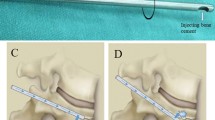Abstract
Purpose
To investigate the surgical effects of modified kyphoplasty with controllable balloon dilatation for treatment of thoracolumbar osteoporotic vertebral compression fractures (OVCF).
Methods
From April 2013 to October 2017, a total of 53 patients with thoracolumbar OVCF were treated with controllable balloon percutaneous kyphoplasty (C-PKP). Peri-operative parameters including days from injury to operation, operation time, injected cement volume, cement leakage and complications were collected. Visual analogue scale (VAS) and Cobb angle before and after operation were applied to evaluate surgical effects. Moreover, a total of 53 cases treated with traditional balloon of percutaneous kyphoplasty were retrospectively analyzed and compared with C-PKP in above parameters.
Results
C-PKP achieved significant fewer events of cement leakage (type C) than that of traditional PKP (5/53 vs 13/53, p < 0.01). The patients were followed up for 10.8 ± 4.2 months; VAS and Cobb angle of the injured vertebra in both two groups at three days and final follow-up were significantly improved compared with that before surgery (p < 0.05), while there were no significant differences between the two groups regarding the VAS and Cobb angle at corresponding time points (p > 0.05).
Conclusions
C-PKP technology is a safe and efficient way for the treatment of thoracolumbar OVCF, and it can reduce cement leakage.




Similar content being viewed by others
References
Lee SK, Lee SH, Yoon SP et al (2014) Quality of life comparison between vertebroplasty and kyphoplasty in patients with osteoporotic vertebral fractures. Asian Spine J 8(6):799–803. https://doi.org/10.4184/asj.2014.8.6.799
Drampalos E, Nikolopoulos K, Baltas C et al (2015) Vertebral fracture assessment: current research status and application in patients with kyphoplasty. World J Orthop 6(9):680–687. https://doi.org/10.5312/wjo.v6.i9.680
Cummings SR, Melton LJ (2002) Epidemiology and outcomes of osteoporotic fractures. Lancet. 359(9319):1761–1767. https://doi.org/10.1016/S0140-6736(02)08657-9
Yang S, Liu Y, Yang H et al (2016) Risk factors and correlation of secondary adjacent vertebral compression fracture in percutaneous kyphoplasty. Int J Surg 36(Pt A):138–142. https://doi.org/10.1016/j.ijsu.2016.10.030
Svedbom A, Hernlund E, Ivergard M et al (2013) Osteoporosis in the European Union: a compendium of country-specific reports. Arch Osteoporos 8:137. https://doi.org/10.1007/s11657-013-0137-0
Kanayama M, Oha F, Iwata A et al (2015) Does balloon kyphoplasty improve the global spinal alignment in osteoporotic vertebral fracture? Int Orthop 39(6):1137–1143. https://doi.org/10.1007/s00264-015-2737-3
Krappinger D, Kastenberger TJ, Schmid R (2012) Augmented posterior instrumentation for the treatment of osteoporotic vertebral body fractures. Oper Orthop Traumatol 24(1):4–12. https://doi.org/10.1007/s00064-011-0098-7
Zou D, Zhang K, Ren Y (2015) Therapeutic effects of PKP on chronic painful osteoporotic vertebral compression fractures with or without intravertebral cleft. Int J Clin Exp Med 8(9):15780–15786
Du J, Li X, Lin X (2014) Kyphoplasty versus vertebroplasty in the treatment of painful osteoporotic vertebral compression fractures: two-year follow-up in a prospective controlled study. Acta Orthop Belg 80(4):477–486
Robinson Y, Tschoke SK, Stahel PF et al (2008) Complications and safety aspects of kyphoplasty for osteoporotic vertebral fractures: a prospective follow-up study in 102 consecutive patients. Patient Saf Surg 2:2. https://doi.org/10.1186/1754-9493-2-2
Bouza C, Lopez-Cuadrado T, Cediel P et al (2009) Balloon kyphoplasty in malignant spinal fractures: a systematic review and meta-analysis. BMC Palliat Care 8:12. https://doi.org/10.1186/1472-684X-8-12
Xu Z, Hao D, Liu T et al (2016) Cause analysis of open surgery used after percutaneous vertebroplasty and kyphoplasty. Med Sci Monit 22:2595–2601
Yeom JS, Kim WJ, Choy WS et al (2003) Leakage of cement in percutaneous transpedicular vertebroplasty for painful osteoporotic compression fractures. J Bone Joint Surg (Br) 85(1):83–89
Wang C, Fan S, Liu J et al (2014) Basivertebral foramen could be connected with intravertebral cleft: a potential risk factor of cement leakage in percutaneous kyphoplasty. Spine J 14(8):1551–1558. https://doi.org/10.1016/j.spinee.2013.09.025
Zhang JN, Fan Y, He X, et al(2018) Is percutaneous kyphoplasty the better choice for minimally invasive treatment of neurologically intact osteoporotic Kümmell’s disease? A comparison of two minimally invasive procedures. Int Orthop
Costa F, Ortolina A, Cardia A et al (2009) Efficacy of treatment with percutaneous vertebroplasty and kyphoplasty for traumatic fracture of thoracolumbar junction. J Neurosurg Sci 53(1):13–17
Watts NB, Harris ST, Genant HK (2001) Treatment of painful osteoporotic vertebral fractures with percutaneous vertebroplasty or kyphoplasty. Osteoporos Int 12(6):429–437. https://doi.org/10.1007/s001980170086
Li Z, Liu T, Yin P et al (2019) The therapeutic effects of percutaneous kyphoplasty on osteoporotic vertebral compression fractures with or without intravertebral cleft. Int Orthop 43(2):359–365. https://doi.org/10.1007/s00264-018-4007-7
Hulme PA, Krebs J, Ferguson SJ et al (2006) Vertebroplasty and kyphoplasty: a systematic review of 69 clinical studies. Spine (Phila Pa 1976) 31(17):1983–2001. https://doi.org/10.1097/01.brs.0000229254.89952.6b
Hutton WC, Elmer WA, Boden SD et al (1999) The effect of hydrostatic pressure on intervertebral disc metabolism. Spine (Phila Pa 1976) 24(15):1507–1515
Li YX, Guo DQ, Zhang SC et al (2018) Risk factor analysis for re-collapse of cemented vertebrae after percutaneous vertebroplasty (PVP) or percutaneous kyphoplasty (PKP). Int Orthop 42(9):2131–2139. https://doi.org/10.1007/s00264-018-3838-6
Liu H, Liu B, Gao C et al (2018) Injectable, biomechanically robust, biodegradable and osseointegrative bone cement for percutaneous kyphoplasty and vertebroplasty. Int Orthop 42(1):125–132. https://doi.org/10.1007/s00264-017-3674-0
Author information
Authors and Affiliations
Corresponding authors
Ethics declarations
Conflict of interest
The authors declare that they have no conflict of interest.
Additional information
Publisher’s note
Springer Nature remains neutral with regard to jurisdictional claims in published maps and institutional affiliations.
Dexin Wang and Zheng Li should be considered co-first authors
Electronic supplementary material
ESM 1
(DOCX 4042 kb)
Rights and permissions
About this article
Cite this article
Wang, D., Li, Z., Yin, S. et al. Modified kyphoplasty with controllable balloon dilatation for treatment of thoracolumbar osteoporotic vertebral compression fractures. International Orthopaedics (SICOT) 44, 1401–1408 (2020). https://doi.org/10.1007/s00264-020-04592-z
Received:
Accepted:
Published:
Issue Date:
DOI: https://doi.org/10.1007/s00264-020-04592-z




